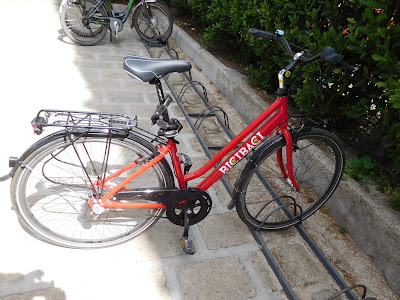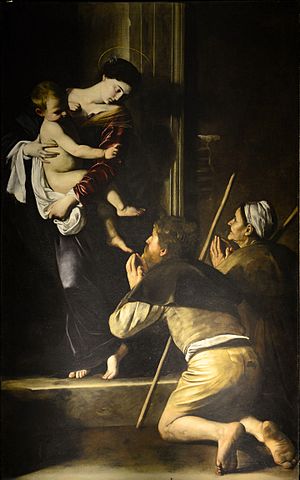Bikes and Kisses.
That was the name of the place from which I rented my bike when I was in Rome.
With a name like that, how could I go anywhere else?
Actually, it's called Bici & Baci, which of course has a rhyme and consonance the translation loses. As I mentioned in an earlier post, they also rent Vespas and, in fact, the branch I patronized has a Vespa museum.
The branch in question is near the foot of the Via Cavour, only a few pedal strokes away from the Forum and Colosseum. Other branches are found near the Piazza Spagna (at the foot of the Spanish Steps) and la Piazza della Repubblica.
The real charm of the Via Cavour branch, though--aside from its location--is the folks who work there. Especially Roberto, who guided me around on my first day. The three-hour tour is 30 Euros and Roberto gave me a choice between the "tourist sites" tour and one of "hidden Rome". Of course, I took the latter and was treated to some interesting stories, made all the more interesting by Roberto's storytelling as well as his intimate knowledge of the city. (I tipped him 20 Euros!)
The bike rental fee is 12,5 (that's 12.50) Euros per day, but I was charged 40 Euros for 4 days. They will place a "hold" of 200 Euros on your credit card if you keep the bike overnight--which, of course, is removed when you return the bike.
Another recommendation is for the hotel in which I stayed: Il Tirreno. The location is hard to beat: literally steps from the Santa Maria Maggiore Basilica (which is worth visiting for its ceiling alone!) and about a five-minute walk from Bici & Baci, the Forum and the Colosseum. About ten minutes in the other direction will take you to Termini, the city's central depot for intercity--as well as airport-bound-- buses and trains.
It's on a very narrow street--an alley, really--that winds from the Basilica down to the Via Cavour, which in turn slopes down to the Forum.
My room was small but well-kept and clean. Since I usually get in late after a full day of riding (or walking) and sightseeing, I really don't ask much more of a hotel room. Also, the breakfast selection is decent (the usual rolls, butter, coffee, cereal, etc, as well as fruit and hard-boiled eggs) and abundant. There is also a nice little patio/terrace where you can sit and eat, drink or whatever.
The best part of the Tirreno, though, is the staff: They are friendly and helpful with everything from suggestions for places to go and services.
One of their suggestions included a tiny restaurant directly across the street/alley: Il Brigantino. It's really more of a pizzeria than an restaurant, and it's easy to miss. But I had an utterly decadent pie made with buffalo mozzarella, porcini mushrooms and a local ham. The lighting is low, but it's has a friendly, inviting "vibe", mainly because of the people in it!
That was the name of the place from which I rented my bike when I was in Rome.
With a name like that, how could I go anywhere else?
Actually, it's called Bici & Baci, which of course has a rhyme and consonance the translation loses. As I mentioned in an earlier post, they also rent Vespas and, in fact, the branch I patronized has a Vespa museum.
The branch in question is near the foot of the Via Cavour, only a few pedal strokes away from the Forum and Colosseum. Other branches are found near the Piazza Spagna (at the foot of the Spanish Steps) and la Piazza della Repubblica.
The real charm of the Via Cavour branch, though--aside from its location--is the folks who work there. Especially Roberto, who guided me around on my first day. The three-hour tour is 30 Euros and Roberto gave me a choice between the "tourist sites" tour and one of "hidden Rome". Of course, I took the latter and was treated to some interesting stories, made all the more interesting by Roberto's storytelling as well as his intimate knowledge of the city. (I tipped him 20 Euros!)
The bike rental fee is 12,5 (that's 12.50) Euros per day, but I was charged 40 Euros for 4 days. They will place a "hold" of 200 Euros on your credit card if you keep the bike overnight--which, of course, is removed when you return the bike.
Another recommendation is for the hotel in which I stayed: Il Tirreno. The location is hard to beat: literally steps from the Santa Maria Maggiore Basilica (which is worth visiting for its ceiling alone!) and about a five-minute walk from Bici & Baci, the Forum and the Colosseum. About ten minutes in the other direction will take you to Termini, the city's central depot for intercity--as well as airport-bound-- buses and trains.
It's on a very narrow street--an alley, really--that winds from the Basilica down to the Via Cavour, which in turn slopes down to the Forum.
My room was small but well-kept and clean. Since I usually get in late after a full day of riding (or walking) and sightseeing, I really don't ask much more of a hotel room. Also, the breakfast selection is decent (the usual rolls, butter, coffee, cereal, etc, as well as fruit and hard-boiled eggs) and abundant. There is also a nice little patio/terrace where you can sit and eat, drink or whatever.
The best part of the Tirreno, though, is the staff: They are friendly and helpful with everything from suggestions for places to go and services.
One of their suggestions included a tiny restaurant directly across the street/alley: Il Brigantino. It's really more of a pizzeria than an restaurant, and it's easy to miss. But I had an utterly decadent pie made with buffalo mozzarella, porcini mushrooms and a local ham. The lighting is low, but it's has a friendly, inviting "vibe", mainly because of the people in it!































